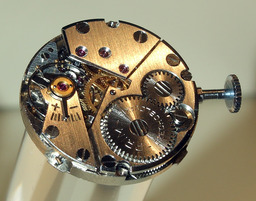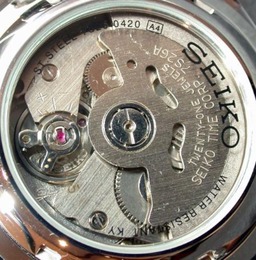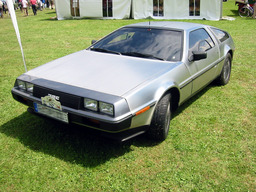"Straight Graining" is one name for the horological finish consisting of abrasively produced scratches running in parallel straight lines across a part. "Brushing" is the name for a very similar process of metal finishing found in general engineering.
See the A. Lange & Sohne web page at http://www.alange-soehne.com/cms/en/manufactory/superb-craftsmanship/artistic-decorations.html, which describes this process with this term ("Straight Graining").
I don't know that there is any strict definition of the difference, if any, between "straight graining" as found in watchmaking and the brushed metal finishes of general engineering and manufacturing. It seems to me to be a matter of scale and degree. Both processes are produced by similar abrasive methods. Watch parts are tiny and are carefully finished; the graining on them tends to be regular and often to run the entire width of the component. Manufactured products given brushed finishes are generally much larger (anything from a handheld item through the St. Louis arch); maintaining the regularity of finish found in watchmaking would be impossible at this scale.
A detail of an Omega Calibre 321 watch tekan by flickr user "Malenkov in Exile" (Shane Lin). The flat steel components have a straigh grained finish. (The case also appears to have a circular grained finish.)

(Photograph by flickr user "Malenkov in Exile" (Shane Lin) at http://www.flickr.com/photos/8869879@N05/5013939711. License: Creative Commons Attribution-ShareAlike 2.0. This image also appears in Wikimedia Commons at https://commons.wikimedia.org/wiki/File:Omega_Cal._321_Chronograph_movement.jpg)
Below are two images which show straight graining very clearly (though from the point of view of watchmaking they are not to my personal taste). The one at left is from Wikimedia Commons, where it is describe thus (in Czech): "Hodinkový strojek značky Prim, hodinářská expozice, Městské muzeum Nové Město nad Metují" (English: Prim clockwork of a wristwatch, watchmaking exhibition, Municipal Museum, Nove Mesto nad Metuji, Czech Republic." The one at right is also from Wikimedia Commons; of an Automatic Seiko 7s26 movement.


(Left image above from Wikimedia Commons, by user Kozuch. License: Creative Commons Attribution ShareAlike 3.0. Location: http://commons.wikimedia.org/wiki/File:Prim_clockwork.jpg Right image also from Wikimedia Commons, by user "Poor Man watch." License: Public Domain. Location: https://commons.wikimedia.org/wiki/File:Seiko_7s26_Movement.jpg )
Below left is a sample of a brushed finish on aluminum. Below right is a sample of a brushed finish on what is almost certainly stainless steel (it is identified as a faucet).


(Both images from Wikimedia Commons. Left image by user Andrezadnik at http://commons.wikimedia.org/wiki/File:Brushed_Aluminium.jpg. License: Creative Commons Attribution-ShareAlike 3.0 Unported. Right image by user Gordeonbleu at http://commons.wikimedia.org/wiki/File:Brushed_metal.jpg. License: Public Domain.)
Here are two relatively well-known brushed-metal things (in both cases brushed stainless steel): the Gateway Arch of the Jefferson National Expansion Memorial in St. Louis, Missouri and a 1981 DeLorean DMC-12 automobile.


(Both images from Wikimedia Commons. The first, from http://commons.wikimedia.org/wiki/File:St_Louis_night_expblend_cropped.jpg is a derivative work cropped from a photograph by Daniel Schwen, also on Wikimedia Commons: http://commons.wikimedia.org/wiki/File:St_Louis_night_expblend.jpg License: Creative Commons Attribution-ShareAlike 2.5 Generic, 3.0 Unported, or GFDL. The second, from http://commons.wikimedia.org/wiki/File:Delorean_dmc12_front.jpg is by user LSDSL. License: Creative Commons Attribution-ShareAlike 3.0 Unported.)
The photograph by flickr user "Malenkov in Exile" (Shane Lin) of an Omega 321 is licensed under the Creative Commons Attribution-ShareAlike 2.0 license.
The photograph by Wikimedia Commons user Kozuch is licensed under the Creative Commons Attribution-ShareAlike 3.0 license.
The photograph by Wikimedia Commons user "Poor Man watch" is in the public domain.
The photograph by Wikimedia Commons user Andrezadnik is licensed under the Creative Commons Attribution-ShareAlike 3.0 license.
The photograph by Wikimedia Commons user "Gordeonbleu" is in the public domain.
The photograph by Wikimedia Commons user Daniel Schwen and the derived version used here is licensed under the Creative Commons Attribution-ShareAlike 2.5 license.
The photograph by Wikimedia Commons user LSDSL is licensed under the Creative Commons Attribution-ShareAlike 3.0 license.
All portions of this document not noted otherwise are Copyright © 2012 by David M. MacMillan and Rollande Krandall.
Circuitous Root is a Registered Trademark of David M. MacMillan and Rollande Krandall.
This work is licensed under the Creative Commons "Attribution - ShareAlike" license. See http://creativecommons.org/licenses/by-sa/3.0/ for its terms.
Presented originally by Circuitous Root®
Select Resolution: 0 [other resolutions temporarily disabled due to lack of disk space]